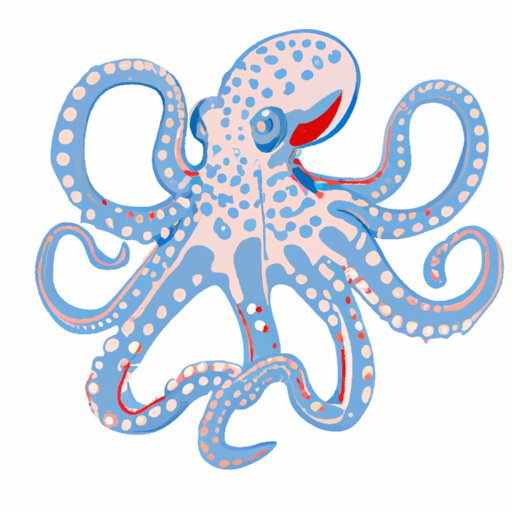
Introduction
If you are a beginner artist with a passion for marine life, you may find drawing an octopus overwhelming. However, with practice and patience, drawing an octopus can be a fun and exciting experience. This step-by-step tutorial will guide you through the process of drawing an octopus, provide tips and tricks to make it look more realistic, and explore the mythological and symbolic significance of this intriguing sea creature.
Step-by-Step Tutorial
Begin by sketching a circle for the head and add a curved line beneath the circle to represent the mouth. Next, draw two small circles on the top of the head to serve as the octopus’s eyes. To create the tentacles, draw eight curved lines extending from the bottom of the head. Make the tentacles slightly shorter and thinner towards the head and thicker and longer at their end. Draw the suckers on each tentacle by adding small circles along the length of each tentacle.
To make the octopus look more realistic, study its anatomy carefully. Pay attention to the curvature of the tentacles, their pattern, and how they attach to the head. Add details such as the webbing between the tentacles and use shading to create depth and dimensionality. You can also experiment with different textures to mimic the roughness of the octopus’s skin.
Comparison to Other Sea Creatures
Octopuses are unique creatures with distinct physical characteristics. Unlike other sea creatures such as fish or dolphins, they have eight arms, no bones, and can change their color and texture. Additionally, octopuses have three hearts and a beak-like mouth, which they use to catch prey. These differences allow octopuses to move differently and camouflage themselves better than other sea creatures.
Tools and Materials
To draw an octopus, you need basic drawing tools such as pencils, erasers, paper, and a ruler. You can also use pen, markers, or ink to add more detail and texture to the drawing. If you are looking for more specific drawing tools, visit your local art supply store or an online retailer.
Exploring Symbolism
Octopuses have been a part of many cultures and mythologies worldwide. In Greek mythology, the octopus was often depicted as a symbol of Medusa’s hair, a powerful and dangerous being with snake-like locks. In Polynesian culture, the octopus symbolizes shape-shifting and transformation. Throughout history, octopuses have also been associated with mystery, intelligence, and adaptability.
Using Different Mediums
Experiment with different drawing mediums depending on your preferences and skill set. If you enjoy pencil drawing, use different grades of graphite to add depth, or experiment with colored pencils for a unique look. Ink is another excellent medium that can help highlight the various textures in an octopus’s body, especially in the suckers. For a more vibrant depiction, you can use watercolor or acrylic paints.
Common Mistakes
The most common mistakes beginners make when drawing an octopus include drawing the tentacles too straight, not adding enough texture to the skin, and making the head too small or too large in proportion to the tentacles. To avoid these issues, take reference photos, and study the anatomy of the animal thoroughly. Be patient, and practice regularly to improve your skills.
Conclusion
Drawing an octopus is a rewarding experience that can help improve your drawing skills and help you appreciate marine life better. By following these tips and techniques, you can create a realistic depiction of this fascinating creature. Remember to experiment with different materials, practice regularly, and enjoy the creative process.




